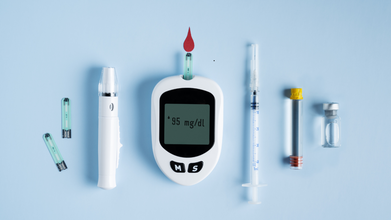- Health Conditions A-Z
- Health & Wellness
- Nutrition
- Fitness
- Health News
- Ayurveda
- Videos
- Medicine A-Z
- Parenting
Hundreds Report Pancreatitis After Using Weight-Loss Drugs; UK Launches A Study To Investigate

Credits: Canva
After many people reported problems with their pancreas post taking weight loss and diabetes injections, the UK health officials launched a study to look into side-effects of these drugs.
Cases of pancreatitis, which causes inflammation of the pancreas, which is a gland located behind the stomach, has been fatal. These cases have been linked to GLP-1 medicines, also the glucagon-like peptide-1 receptor agonists.
Acute Pancreatitis: The Background
The UK’s Medicines and Healthcare products Regulatory Agency (MHRA) is investigating a rise in reports of acute pancreatitis potentially linked to GLP-1 weight-loss medications. This follows an increase in submissions to the MHRA’s Yellow Card scheme, which tracks adverse reactions to medicines and medical devices.
What Happens In Acute Pancreatitis?
Acute pancreatitis is a sudden inflammation of the pancreas, a digestive gland behind the stomach, and often requires hospitalisation. Symptoms include intense abdominal pain, nausea, and fever. GLP-1 drugs, such as Mounjaro (tirzepatide), Wegovy and Ozempic (semaglutide), and liraglutide, list pancreatitis as an “uncommon” side effect, estimated to affect up to one in 100 users.
To date, nearly 400 cases of acute pancreatitis have been reported in relation to these drugs, with 181 linked to Mounjaro. Alarmingly, over a quarter of those reports have emerged in 2025 alone. This year, the Yellow Card scheme has recorded 101 cases related to tirzepatide and 22 tied to semaglutide.
Also Read: Commonwealth Swimmer Archie Goodburn And His Journey With A Rare Cancer That Kills Before 40
Acute Pancreatitis: What Did The Authorities Say?
An MHRA spokesperson noted: “With increased usage, we’re seeing more Yellow Card reports involving GLP-1 medicines and acute pancreatitis.” While there’s currently no known genetic link, the MHRA is exploring whether genetics might influence susceptibility to such side effects. It has called on both patients and healthcare professionals to report suspected drug-related pancreatitis.
The Study on Acute Pancreatitis: Who Can Be Part Of It?
Those affected may be invited to join the Yellow Card Biobank study, conducted with Genomics England. Participants will provide health information and saliva samples to help researchers investigate genetic factors that may affect drug reactions.
Dr Alison Cave, MHRA’s chief safety officer, said nearly a third of all medicine side effects could be preventable with genetic testing, which may also help reduce the estimated £2.2 billion annual cost of adverse drug reactions to the NHS.
Drug manufacturers have responded to the concerns. Eli Lilly, which makes Mounjaro, stated that patient safety remains a top priority and noted that pancreatitis is already listed as a known side effect. Novo Nordisk UK, maker of Ozempic and Wegovy, also stressed the importance of using GLP-1 medications only under medical supervision, while continuing to monitor safety data closely.
Also Read: World Drug Day 2025: Why Is It Important For Us To Observe This Day?
The MHRA’s ongoing investigation aims to improve understanding of these side effects as GLP-1 medications become more widely used for managing obesity and diabetes.
Who Was Ludwig Minelli, Founder of the Swiss Right-to-Die Organization, Who Died by Assisted Suicide at 92?

Credits: AP
Ludwig Minelli, 92, died on Saturday just days before his 93rd birthday, which would have been on December 5. He was the founder of Swiss right-to-die organization Dignitas. He has died by assisted suicide.
The members of organization paid tribute to him and said that he had always led a "life for freedom of choice, self-determination, and human rights".
Right-To-Die By Minelli
Minelli founded Dignitas in 1998, which has helped many people to choose how they wish to die with dignity. He however began his career as a journalist and worked as a correspondent for the German news magazine Der Spiegel. He then studied law and that is when his interest in human rights took off.
Throughout his life, he campaigned for the right to die and gave Dignitas the slogan: "dignity in life, dignity in death".
"I am persuaded that we have to struggle in order to implement the last human right in our societies. And the last human right is the right to make a decision on one's own end, and the possibility to have this end without risk and without pain," he said in a 2010 BBC interview.
He founded Dignitas after he split from an older Swiss assisted dying organization, Exit, because he said the rules felt too restrictive.
The reason for Dignitas to become famous was because the way it operated. Dignitas offered assisted suicide to non-Swiss citizens who travel to Switzerland because assisted dying is not permitted in their own countries. In a 2008 interview to Der Tagesspiegel, he said that Dignitas assisted 840 people to die, and 60% of them were Germans.
His Life Amid Criticism And Legal Battles
While he devoted his life for a cause, he was not spared from criticism. He was often criticized for an alleged lack of transparency over the financial dealings of the organization. He was further criticized for offering assisted dying options to those who were not terminally ill, but wanted to end their lives. He also faced numerous legal battles, and many of which were also appealed to Swiss apex court.
The Wins He Made
As per Dignitas, his work had a lasting influence. In 2011, the European Court of Human Rights announced the right of a person capable of judgment to decide on the manner and the time of their own end of life.
While in his own country, assisted dying was permitted under Swiss law since 1942, under strict condition, of course, Euthanasia still remains illegal there.
The main difference is that in Switzerland, a physician cannot administer a lethal injection, which is what euthanasia is. However, a physician can provide the means for a person to end their own life, and the individual must perform the final act themselves.
The legality of assisted suicide is based on Article 115 of the Swiss Criminal Code from 1942, which prohibits assistance only if motivated by selfish reason. The conditions for assisted suicide includes that the assistance must not be for selfish motives and must be provided to someone of sound mind who has made a self-determined and enduring decision to die. The person must also be suffering from an unbearable and uncontrollable condition.
Your Butt Shape Could Be a Clue to Your Diabetes Type; Here’s How

Credits: Canva
The shape of your gluteus maximus, the largest muscle in your backside, may offer surprising clues about your likelihood of developing diabetes. New research suggests that the contours of this major muscle change with age and health conditions, helping scientists better understand how fitness, muscle health, and metabolism are connected.
Ageing, Weight, and Diabetes: What We Already Know
For years, the NHS has warned that ageing and excess weight increase the risk of developing Type 2 diabetes. However, this new study goes beyond traditional measures, proposing that the shape of the gluteus maximus itself shifts as people age or develop conditions such as osteoporosis or diabetes. These subtle muscular changes could provide valuable information about a person’s metabolic health.
Why the Gluteus Maximus Matters
Researchers from the University of Westminster highlighted that the gluteus maximus plays a key role not just in movement but also in metabolic regulation. Healthy, well-maintained muscles can improve blood sugar control and reduce the burden on organs involved in glucose processing.
Dr Marjola Thanaj, co-author of the study from the university’s Research Centre for Optimal Health, explained, as reported by Independent: “People with higher fitness, as measured by vigorous physical activity and hand grip strength, had a greater gluteus maximus shape, while ageing, frailty and long sitting times were linked to muscle thinning.”
Mapping the Muscle
To understand these differences, researchers used advanced MRI 3D mapping to create a detailed anatomical model of the gluteus maximus. By analyzing more than 61,000 MRI scans from the UK Biobank database, they discovered that the shape, not the size, of the muscle varied significantly between individuals with diabetes and those without it.
What the Study Found
The MRI analysis revealed distinct, sex-specific patterns linked to Type 2 diabetes. Among male participants living with the disease, those classified as “frail” showed widespread muscle shrinkage across the gluteus maximus, indicating a loss of muscle quality and strength.
Women with diabetes, on the other hand, had enlarged muscle shapes — not because of increased muscle strength, but because of fat infiltrating the muscle tissue. This type of fat infiltration often signals declining muscle function and poorer metabolic health.
Dr Thanaj said these patterns underline a crucial point: men and women can experience the same illness in very different biological ways, which may influence diagnosis and treatment strategies in the future.
Why Maintaining Muscle Mass Matters
Beyond appearance or strength, muscle health is essential for long-term wellbeing. Maintaining muscle mass supports blood sugar regulation, reduces the risk of cardiovascular disease, and lowers the likelihood of developing fatty liver disease, all conditions closely linked to metabolic health.
Professor Louise Thomas, senior author of the study, told The Times: “Maintaining muscle mass as we age is one of the most important things we can do for our long-term health. If people understand how important their muscles are, and make small changes to keep them healthy, that could have a huge impact on disease across the population.”
Small Steps to Strengthen Your Glutes
Improving glute muscle health doesn’t require intense gym sessions. Simple actions such as taking the stairs instead of the lift, adding squats or lunges to your routine, or breaking up long periods of sitting can help tone and strengthen the gluteus maximus.
4 Simple Tests That Can Detect Kidney Diseases Early, According To Doctor

Credits: Canva
Kidney disease is rising at an alarming pace worldwide, and it’s now among the top causes of death. A Lancet study highlights that the number of people living with chronic kidney disease jumped from 78 million in 1990 to nearly 788 million in 2023. That’s a massive tenfold spike, and a reminder that our kidneys need more attention than we realize.
The tricky part? Kidney problems often progress silently. Many people don’t realize anything is wrong until the kidneys are already significantly damaged. That’s why experts strongly emphasize early screening. According to nephrologists like Dr Arjun Sabharwal, a few simple tests — often quick and inexpensive — can help catch kidney issues early and improve treatment outcomes.
Below are the four key tests everyone should know about, especially if you have diabetes, high blood pressure, a family history of kidney disease, or you’re simply trying to stay proactive about your health.
Creatinine Blood Test & eGFR: Your First Kidney Health Check
Creatinine is a waste product filtered out by the kidneys. A routine blood test measures its level, but creatinine alone doesn’t tell the full story. That’s where eGFR (Estimated Glomerular Filtration Rate) comes in.eGFR uses creatinine values along with age and other factors to estimate how well your kidneys are functioning overall. Doctors often say, “Creatinine is just a number — eGFR tells you how much your kidneys are working.”
An eGFR below normal may be an early signal that your kidneys aren’t filtering efficiently, even if you feel fine.
Cystatin C: A More Accurate Indicator for Some People
Cystatin C is a protein produced naturally by all cells. When kidneys are healthy, its levels stay stable; when the kidneys struggle, the levels rise.
Experts highlight that Cystatin C can be more reliable than creatinine for people with very high muscle mass, those who work out intensely, or individuals taking supplements that may affect creatinine readings. If creatinine results seem unclear or inconsistent, this test adds clarity.
Urine Dipstick Test: Quick and Tells You a Lot
Before kidney function takes a major hit, the body often shows early warnings — one of which is protein leakage in urine. A urine dipstick test is one of the fastest ways to detect this.
A chemically treated strip is dipped into your urine sample, and if proteins like albumin are present, the strip changes color. It’s simple, non-invasive, and helpful for spotting early kidney damage.
Urine Protein-to-Creatinine Ratio (UPCR): How Much Protein Is Leaking
If a dipstick shows abnormalities, the next step is often a UPCR test. This test measures exactly how much protein is leaking into the urine relative to creatinine. Higher levels may signal worsening kidney function or underlying disease. Doctors use UPCR to assess the severity of kidney damage and monitor progress over time.
When to See a Nephrologist
If any test shows rising creatinine, an abnormal eGFR, protein in urine, or blood detected on a dipstick, it’s crucial to book an appointment. Lifestyle tweaks, home remedies, or detox drinks cannot reverse kidney damage. Expert evaluation is essential.
© 2024 Bennett, Coleman & Company Limited

